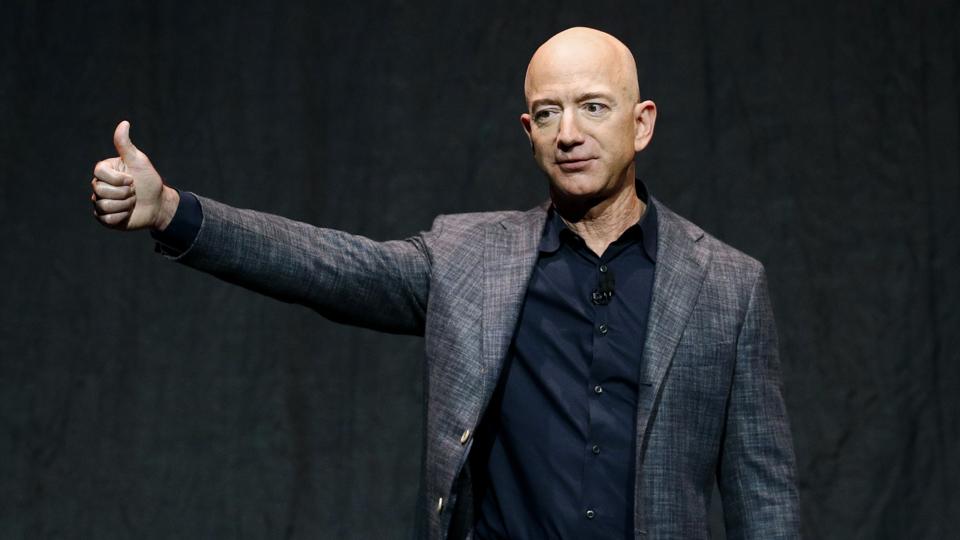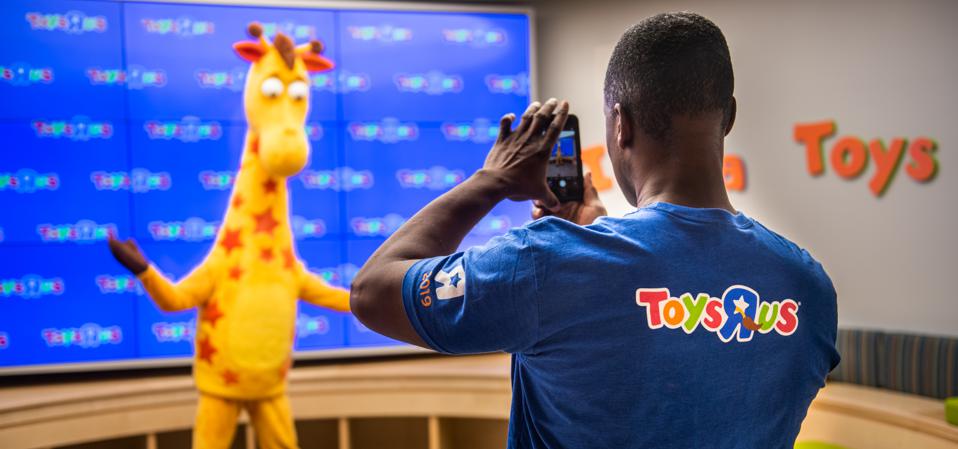Toys R Us, and its mascot, Geoffrey the Giraffe, have to find a new digital partner now that a deal … [+] © 2019 BLOOMBERG FINANCE LP
By Joan Verdon
Source: www.forbes.com, August 2020
Ten months ago, the resurrected Toys R Us brand made news when it announced an e-commerce partnership with Target TGT +0.4%.
Last month, Toys R Us and Target quietly ended that partnership.
Now, toys featured on the Toys R Us website have a click-to-buy link to Amazon AMZN +0.1%. The last time Toys R Us partnered with Amazon for e-commerce it led to a lawsuit, and delays caused by that ill-fated partnership were a key factor in the eventual death of Toys R Us.
E-commerce was the Achilles heel of the old Toys R Us. Its digital mistakes – including that spectacularly near-sighted partnership with Amazon in 2000, and a decade of false steps in developing its own e-commerce operation – played a big role in the 2017 bankruptcy and 2018 liquidation of what once was the largest U.S. toy retailer.
Now, the new Toys R Us will have to get its digital game together if it is going to execute on its plan to revive the brand as, in the words of Richard Barry, CEO of Toys R Us parent company, Tru Kids Inc., an “experiential and content-rich omnichannel concept.”
Spokespersons for Toys R Us and Target confirmed that the partnership had expired but did not elaborate on why, or on Toys R Us’ plans going forward. Amazon did not respond to a request for comment.
The switch from Target.com purchase links to Amazon links on the Toys R Us website was first reported on by James Zahn, senior editor of The Toy Book, The Toy Insider, and The Pop Insider, in a Toy Book article at the end of July.
“By using the Amazon Associates’ links, Toys R Us – in a digital sense – isn’t functioning as a retailer, but rather as a publisher,” Zahn said in an interview this week. “If the company is able to scale itself again following the pandemic, they will need a distribution and fulfillment infrastructure, a role that Target was said to be performing.”
The Target e-commerce partnership was heavily promoted in the experimental Toys R Us stores that opened in Paramus, N.J. and Houston, TX last fall, Zahn noted.
“One of the key features of the new physical stores was that families shopping in-store could access Target’s complete assortment from digital menu screens,” Zahn said. “Now what will they be told – go to Amazon?”
Veteran toy industry publisher and analyst Jim Silver, owner of toy review website TTPM.com, said Toys R Us may be better off not being locked in to an exclusive digital partnership with Target. With the Target partnership, shoppers who come to the Toys R Us website were redirected to Target.com.
“I don’t think it was a good long term solution to have the consumer learn that they can bypass your site and go directly elsewhere,” Silver said.

The Target-Toys R Us digital partnership was promoted heavily at the two experimental Toys R Us … [+]
© 2019 BLOOMBERG FINANCE LP
The Amazon links currently in place do the same thing, and may be a short-term option until Toys R Us, and b8ta, its partner in its physical stores, settle on a long-term digital strategy.
“At some point you’ve got to give a person a reason to shop on your site,” Silver said.
Under the now-expired partnership, Target agreed to handle all e-commerce fulfillment for Toys R Us, serving customers looking for toys on the Toys R Us website, as well as in-store shoppers who placed online orders at the new Toys R Us stores.
The Target deal gave Toys R Us a quick and easy way to enable online orders in time for the November opening of its first two stores that are part of its re-branding strategy, and in time for Holiday 2019 – but without having to invest in inventory, or fulfillment centers.
Toys R Us thus far has been using its website as a resource for parents, with video reviews of toys, and activities for families. On the Toys R Us site, as with all Amazon Associate websites, Toys R Us will receive a commission from Amazon if visitors to its site click through and make a purchase from Amazon.
Toys R Us doesn’t need any special partnership or deal with Amazon to be an associate. That option is open to virtually anyone with a website who wants to link to Amazon.
Toys R Us won the short-term battle when it took Amazon to court 15 years ago to end a previous partnership, but the fact that the Toys R Us website now is linking to Amazon shows definitively that Amazon won the war.
Back in 2000, Toys R Us proudly announced a deal to have Amazon create a Toys R Us site on Amazon.com. Amazon would handle all e-commerce site development, and order fulfillment and Toys R Us would pay them $50 million annually for the service.
Comments by Toys R Us executives, and retail analysts at the time, who praised the deal, show how clueless Toys R Us – and many retailers – were about the potential growth of Amazon, and the likelihood that online sales would hurt brick and mortar sales.
At the time of the deal, Toys R Us was obsessed with losing in-store market share to Walmart WMT +2.7% and Target, and saw Amazon and e-commerce as a small threat.
Holiday 1999, when the Toys R Us site crashed repeatedly, and the company failed to deliver Christmas toys on time, should have tipped them off that they needed to figure out their digital presence, fast.
Instead, they turned it over to Amazon, which learned from Toys R Us how to do a much better job of selling toys online, and keeping best-selling hot toys in stock.
Toys R Us executives believed they would be the exclusive toy sellers on Amazon. When they began noticing competitors were also selling toys on Amazon, including Target, they filed a lawsuit to end the agreement.

Amazon founder Jeff Bezos at an event last year for the Blue Origins space program (AP … [+]
ASSOCIATED PRESS
The lawsuit resulted in a court hearing in September 2005 that required Jeff Bezos to sit in a sweltering Paterson, N.J. courthouse with a malfunctioning air conditioner.
Bezos, in three hours of testimony on a muggy mid-September day, gave Toys R Us executives a master class in what to expect from Amazon and e-commerce in the future. (I covered the court proceedings for The Record of North Jersey.) Amazon, he said, never would have agreed to let Toys R Us be the exclusive seller of toys because the purpose of Amazon is to give buyers the broadest number of options for every possible item you can buy or sell.
Toys R Us’ counter-argument basically was ‘
trusted Amazon’ and ‘We thought Amazon (and Bezos) was our friend.’
As he was testifying that day in 2005, Bezos’ net worth was $3.5 billion, which seemed like a huge number then. It is $197.2 billion today.
The judge in Paterson granted Toys R Us what was described as a non-fault divorce from Amazon and allowed it to exit from a 10-year contract. Amazon, after appeals, later agreed to pay Toys R Us $51 million in damages to settle the dispute.
After the split from Amazon, Toys R Us used outside service providers to run its e-commerce operations for the next 10 years. The 2005 private equity buyout that turned Toys R Us from a public company to a highly leveraged private company saddled it with so much debt that it couldn’t invest the way it needed to in e-commerce and omnichannel.
It wasn’t until 2015 that Toys R Us took back in-house control of its websites, and the company was talking about its plans to dramatically upgrade its e-commerce sites up until the final months before filing for bankruptcy.
The old Toys R Us failed, in part, because it took too long to figure out its digital game plan.
Right now, Toys R Us is just a brand name that is available for licensed partnerships designed to leverage the value of a iconic retail name and its beloved mascot Geoffrey and “I’m a Toys R Us kid” jingle. It has minimal expenses and it can wait out the pandemic, and wait to see what retail’s next normal will look like.
But it needs to come up with a better plan than just being an Amazon Associate.

